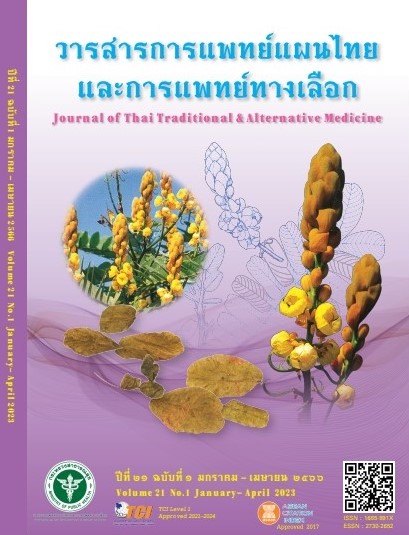A Systematic Review of Herbal Medicinal Formulas for Skin Disease Treatment with Thai Traditional Medicine Wisdom
Main Article Content
Abstract
This study is a documentary research. The objective of this study was to study the information on the use of herbs and the structure of herbal medicinal formulas used in the treatment of skin diseases of Thai traditional medicine by searching related researches that have been published in electronic databases during the year 2011 to 2021. The results showed that a total of 133 medicinal formulas were collected, including 262 species. By the way, the most common method is applying (72 recipes). Most of the herbs belong to the family LEGUMINOSAE (14 species). The most common medicinal plant with the frequency of treatment of skin diseases was Khao Yen Nuea (4.20). Most of the herbs are rooted for medicinal purposes (79 species). The flavor of most herbal medicines is astringent (34 species). An overview of the structure of dermatological drug formulas, the most favorable, astringent herbs, followed by drunken herbs. The results of this study could be used to study medicinal herbs for skin diseases. Continuing to develop commercial products add value to Thai herbs and can be used as a guideline for the establishment of herbal medicines to treat skin diseases for Thai traditional medicine
Article Details

This work is licensed under a Creative Commons Attribution-NonCommercial-NoDerivatives 4.0 International License.
References
Payungwong Ch. Quality of Life Study of Dermatology Patients at Rayong Hospital [internet]. 2020 [cited 2021 Nov 26]. Available from: https://www.rayonghospital.go.th/images/webpage/06bcb9621a72e9.pdf
Chaloemram C, Sedlak S. Study on Knowledge of Medicinal Plant Formulas for Dermatitis Treatment Recorded in Palm Leaf Manuscripts of Isan. KKU Science Journal. 2020;48(3):350-63.
Sungsuk P, Chokvivat V. A study of the safety and efficacy of Psoriasis treatment with herbal medicine in Chaophraya Abhaibhubejhr Hospital, PrachinBuri Province. Journal of Health Science Research. 2020;14(1):11-20.
Swaddichai C, Sookpaisal W, Chaicharoen pong K, Sanguansap P, Limprapaipong T. The Result of Treatment Psoriatic Patients with Herbal Compounds in Prapokklao Hospital. Journal Prapokklao Hospital Clinical Medical Education Center. 2010;27(4):248-255.
Neamsuvan O, Kama A, Salaemae A, Leesen S, Waedueramae N. A survey of herbal formulas for skin diseases from Thailand’s three southern border provinces. Journal of Herbal Medicine. 2015;5(4):190-8.
Pradeep B, Ganesh RH, Gurumurthi H, Gangadhar SM. Ethnomedicinal plants to cure skin diseases-an account of the traditional knowledge in the coastal parts of Central Western Ghats, Karnataka, India. Journal of Ethnopharmacology. 2014;151(1):493–502.
Chaloemram C. Principles of Using Medicinal Plants in Withikutdharok Scripture. Journal of Thai Traditional and Alternative Medicine. 2020;18(1):147-165.
Foundation for the Rehabilitation and Promotion of Traditional Thai Medicine. Original Thai medical textbook (Medical science, conservation edition). Bangkok: Suphawanich Printing; 2009.
Wongwiwat W, Kleangchan C. Knowledge of Thai traditional healers on utilization of medicinal plants for psoriasis treatment in Nakhon Si Thammarat province. Nakhon Si Thammarat: Rajamangala University of Technology Srivijaya; 2017.
Wonganunt B, Samana R, Lauprasert P. Effect of French Marigold (Tagetes patula Linn.) against Head Lice (Pediculushumanus capitis). KKU Journal for Public Health Research. 2014;7(3):28-33.
Foundation for the Rehabilitation and Promotion of Traditional Thai Medicine. Thai Pharmacy Textbook. 1st. Bangkok: Pickanes Printing Center; 2005.
Tinnakorn na ayuthaya K. Mechanism of action of 9 medicinal flavors in Thai pharmaceuticals. 1st. Nonthaburi: Manpower Development Subdivision Department of Thai Traditional and Alternative Medicine; 2015.


